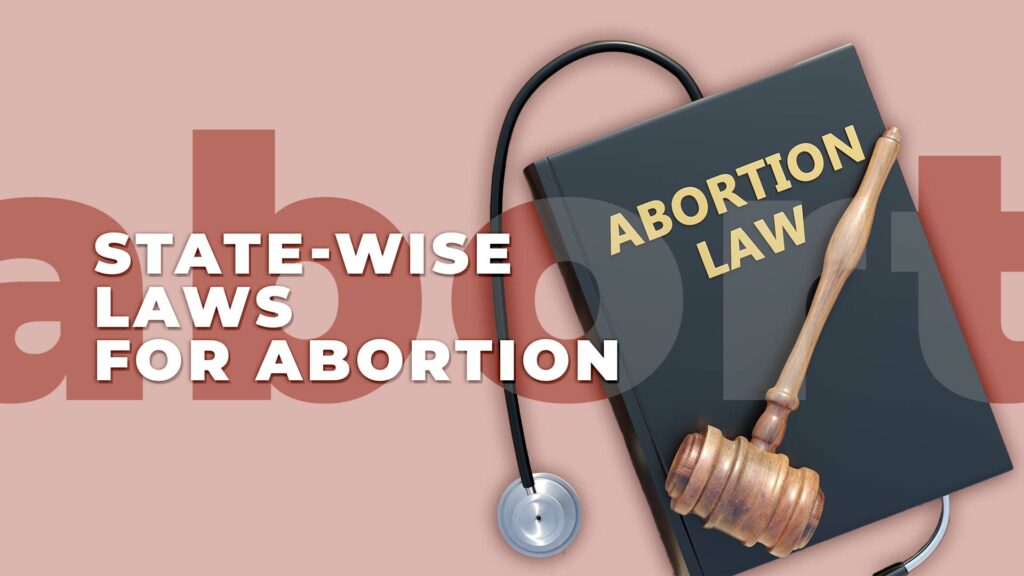Abortion is a highly debated and controversial topic in today’s society. Laws and regulations around abortion vary significantly by state and can have significant implications for women seeking access to safe and legal abortion care. In this article, we will explore the laws around abortion in all 50 U.S. states and Washington, D.C., focusing on when a surgical abortion is considered too late. We will provide evidence-based information on the laws in each state and the potential impact on women’s reproductive rights and access to healthcare.
Types Of Abortion

Abortion methods include medical abortion, vacuum aspiration abortion, dilation and evacuation, and dilation and extraction. The accessibility of these procedures can vary based on various factors, such as the pregnancy stage and geographic location.
Medical Abortion
Medical abortion, also known as medication abortion, is a non-surgical method for terminating a pregnancy that involves using two medications – Mifepristone and Misoprostol.[1] This approach is practical for pregnancies up to ten weeks after the last menstrual period.
Before undergoing the procedure, the patient must undergo a pregnancy test, ultrasound, and medical examination. Gynecologists usually recommend MTP kits for non-surgical abortions. Antibiotics may also be prescribed to prevent infection.
Mifepristone, the first medication, works by blocking the effects of progesterone, a hormone that supports a pregnancy. This causes the uterus lining to break down, preventing the embryo from growing.
After 24-48 hours, the second medication, Misoprostol, is taken.[2] Misoprostol increases uterine contractions, leading to the expulsion of the pregnancy. The patient may experience heavy bleeding for up to a week and other symptoms such as cramping, fever, back pain, stomach pain, and foul-smelling vaginal discharge.[3]
However, medical abortion can also lead to complications such as incomplete expulsion of the pregnancy material, heavy bleeding, uterine infection, and life-threatening infections. It is crucial to seek immediate medical attention if these complications occur. A doctor typically performs a follow-up examination a week later to confirm the successful termination of the pregnancy and rule out any complications.
How Long Before A Medical Abortion Is Too Late
The timing for a medical abortion depends on the specific medication used and the gestational age of the pregnancy.
Mifepristone and misoprostol are commonly used medications for medical abortion. According to the World Health Organization (WHO) guidelines, Mifepristone and Misoprostol can be used for up to 63 days (9 weeks) of gestation. However, some studies have shown that this method can still be effective up to 70 days (10 weeks) of pregnancy.[4]
Another medication used for medical abortion is misoprostol alone. According to the American College of Obstetricians and Gynecologists (ACOG), misoprostol alone can be used up to 10 weeks of gestation.[5] Moreover, the effectiveness of medical abortion decreases as the pregnancy progresses, and there is a higher risk of incomplete abortion and the need for surgical intervention.
Surgical Abortion
A Surgical Abortion, also known as an In-clinic Abortion, is a medical procedure used to terminate a pregnancy. There are three types of surgical abortions, each designed for specific stages of pregnancy.
The first type is Vacuum Aspiration or Suction Abortion, performed during the first trimester of pregnancy, up to 12 weeks after the last menstrual cycle.[6] During the procedure, the woman lies in stirrups on her back with her feet. A speculum is inserted into the vagina to hold it open, and the cervix is numbed with a local anesthetic. With gentle suction, a thin cannula is inserted through the cervix and into the uterus, removing the pregnancy tissue, including the embryo or fetus, placenta, and membranes.
The second type is Dilation and Evacuation (D&E), performed during the second trimester, from 13 to 24 weeks of pregnancy.[7] Before the procedure, the woman is given medication to soften and dilate the cervix. During the process, the healthcare provider uses a series of dilators to widen the cervix and accesses the uterus. The pregnancy tissue is then removed using a combination of suction and surgical instruments, such as forceps and curettes.
The third type is Dilation and Extraction (D&X) or Partial-Birth Abortion, used for late-term pregnancies after 20-24 weeks or later.[8] This procedure is typically performed when the mother’s health is at risk or the fetus has a significant issue. During the process, the cervix is dilated, and the healthcare provider partially delivers the fetus, usually feet first. The base of the fetal skull is then punctured, and the brain is suctioned out, which collapses the head and allows the rest of the fetus to be removed from the uterus.
All three types of surgical abortions are safe and effective, with low risks of complications such as bleeding and infection. Recovery times vary from a few hours to a couple of weeks, depending on the type of abortion and the stage of pregnancy. People should seek medical attention immediately if they experience unusual symptoms or bleeding after the procedure.
How Long Before A Surgical Abortion Is Too Late
The timing of when a surgical abortion is too late depends on various factors, including the laws and regulations of the country or state, the availability of trained medical personnel, and the individual’s health status and gestational age.
In the United States, the legal limit for abortion varies from state to state. Some states prohibit abortions after 20 weeks post-fertilization, while others permit abortions up to 24 weeks or even later in cases of medical necessity. It is crucial to consult with a healthcare provider or abortion clinic to understand the regulations and limitations in your area.
From a medical perspective, the timing of a surgical abortion depends on the gestational age of the pregnancy. Vacuum aspiration abortion, the most common surgical abortion, is typically performed up to 12 weeks after the last menstrual period. Dilation and evacuation, another surgical abortion, usually occurs between 13 to 24 weeks of gestation.
After 24 weeks of gestation, a surgical abortion is generally considered too late, except in cases of medical necessity. In such cases, a doctor may recommend a dilation and extraction (D&X) procedure known as partial-birth abortion. However, this procedure is highly controversial and is only performed in rare cases where the health of the mother or fetus is at risk.
Moreover, the legality and medical limitations of surgical abortion vary depending on individual circumstances. Still, a surgical abortion is generally considered too late after 24 weeks of gestation, except in cases of medical necessity. It is essential to seek medical advice and counseling to understand the options and limitations available.
State-wise Laws for Abortion

Abortion laws in the United States vary by state, and these laws are subject to change. Here is a brief overview of the current state of abortion laws in each state:
NORTH-EASTERN STATES
- Connecticut
According to Connecticut law, there is no specific gestational age limit for when a surgical abortion is too late. The decision to perform an abortion is left up to the physician and their professional medical judgment. However, the physician must ensure the abortion is “medically necessary” for the woman’s health. Connecticut law also requires the woman to give informed consent and receive information on the procedure and its risks.
- Delaware
Delaware law allows surgical abortions up to the point of fetal viability, which is around 24 weeks gestation. After viability, a surgical abortion may only be performed if necessary to preserve the woman’s life or health.
- Maine
In Maine, there is no specific gestational age limit for when a surgical abortion is too late. According to the Maine Family Planning Association, abortion services are available up to 22 weeks and six days from the first day of the last menstrual period (LMP). However, the state does require that abortions after 16 weeks must be performed in a hospital or surgical center licensed by the state.
- Massachusetts
In Massachusetts, a surgical abortion is generally allowed up to 24 weeks from the first day of the last menstrual period. However, after 24 weeks, a surgical abortion may be performed only if necessary to preserve the life or health of the mother. According to Massachusetts law, a physician may perform a post-viability abortion only if it is determined that continuing the pregnancy would pose a greater risk to the mother’s life or physical or mental health than ending the pregnancy.
- Maryland
In Maryland, a surgical abortion is generally allowed up to 20 weeks from the first day of the last menstrual period. After 20 weeks, a surgical abortion may be performed only if the life or health of the mother is at risk or if the fetus has a severe or fatal anomaly. According to Maryland law, a physician may perform a post-viability abortion only if it is determined that continuing the pregnancy would pose a greater risk to the mother’s life or health than ending it.
- New Hampshire
According to New Hampshire law, abortions are generally legal up to the point of viability, typically around 24 weeks gestation. After that point, a surgical abortion may only be performed if the pregnancy threatens the life or health of the woman.
- New Jersey
New Jersey law permits abortions up to 24 weeks of pregnancy. After that point, a surgical abortion may only be performed if the pregnancy poses a severe risk to the woman’s health.
- New York
In 2019, New York passed the Reproductive Health Act, which removed most restrictions on abortion and allowed for abortions to be performed after 24 weeks gestation in cases where the woman’s life or health is at risk, or if the fetus is not viable. Before this law, abortions were generally legal up to 24 weeks gestation.
- Pennsylvania
Pennsylvania law states a surgical abortion may be performed until the 24th week of pregnancy. However, after 24 weeks, a surgical abortion is only allowed to save the pregnant person’s life or prevent the permanent impairment of a primary bodily function.
- Rhode Island
In Rhode Island, a surgical abortion may be performed until the 24th week of pregnancy. After 24 weeks, a surgical abortion is only allowed if it is necessary to preserve the life or health of the pregnant person.
- Vermont
Vermont law allows a surgical abortion until the 24th week of pregnancy. However, after 24 weeks, a surgical abortion is only permitted if it is necessary to preserve the life or health of the pregnant person or if the fetus has a severe fetal anomaly.
- Washington, D.C.
In Washington, D.C., there is no specific gestational age limit for surgical abortion. However, after 24 weeks of pregnancy, the procedure is only allowed if the life or health of the mother is at risk or if the fetus has a fatal abnormality.
SOUTH-EASTERN STATES
- Alabama
In Alabama, it is illegal to perform a surgical abortion after 20 weeks of gestation, except in cases where the mother’s life is in danger, or the fetus has a lethal anomaly.
- Arkansas
In Arkansas, it is illegal to perform a surgical abortion after 20 weeks of gestation, except in cases where the mother’s life is in danger, or the fetus has a lethal anomaly.
- Florida
In Florida, the legal limit for abortion is at 24 weeks. However, if the life or health of the mother is at risk, an abortion can be performed at any point in pregnancy.
- Georgia
In Georgia, abortions are generally prohibited after 20 weeks, except in cases where the pregnancy endangers the mother’s life or poses a “serious risk” to her physical health.
- Louisiana
In Louisiana, abortions are generally prohibited after 20 weeks, except in cases where the pregnancy endangers the mother’s life or poses a “serious risk” to her physical health. (Louisiana Revised Statutes § 40:1061.10) Louisiana has several other restrictions on abortion access, including a 72-hour waiting period and mandatory counseling.
- Mississippi
In Mississippi, a surgical abortion is generally prohibited after 20 weeks post-fertilization, except in cases of severe fetal abnormality or if the mother’s life is in danger. The state’s Gestational Age Act passed in 2018, also requires physicians to report any abortions performed after 15 weeks post-fertilization to the Mississippi Department of Health.
- North Carolina
In North Carolina, a surgical abortion is generally prohibited after 20 weeks post-fertilization, except in cases of a medical emergency or if the mother’s life is in danger. The state’s 20-week abortion ban was signed into law in 2015.
- South Carolina
In South Carolina, a surgical abortion is generally prohibited after 20 weeks post-fertilization, except in cases of a medical emergency or if the mother’s life is in danger. The state’s 20-week abortion ban was signed into law in 2016. In February 2021, the state’s Senate passed a bill banning abortions in South Carolina once a fetal heartbeat is detected, which can be as early as six weeks into pregnancy. However, the bill has not yet been signed into law.
- Tennessee
According to Tennessee Code Annotated § 39-15-201, the state prohibits abortions after viability unless necessary to preserve the life or health of the mother. The law defines viability as the point in pregnancy when, in the attending physician’s judgment, the fetus can sustain survival outside the uterus without applying extraordinary medical measures.
- Kentucky
Kentucky Revised Statutes § 311.720 states that abortions after viability can only be performed if the physician determines that the continuation of the pregnancy poses a risk to the mother’s life or a substantial risk of severe physical impairment. The law defines viability as the stage of gestation when the life of the unborn child may be continued indefinitely outside the womb by natural or artificial life-supportive systems.
- Virginia
In Virginia, the state law allows abortions during pregnancy’s first and second trimester. After 24 weeks of pregnancy, a woman can only obtain an abortion if her doctor determines that continuing the pregnancy would likely result in her death or impair her mental or physical health.
- West Virginia
According to West Virginia Code § 16-2I-2, abortions can be performed up to 20 weeks after the first day of the woman’s last menstrual period. However, the law allows for an exception if the physician determines that the continuation of the pregnancy would endanger the woman’s life or risk substantial and irreversible physical impairment.
MID-WESTERN STATES
- Illinois
In Illinois, surgical abortion can be performed up to viability or when necessary to preserve the health or life of the pregnant person. Viability is generally considered to be around 24 weeks of gestation. However, the law allows for exceptions in cases where the fetus has a severe abnormality or where the continuation of the pregnancy would cause the pregnant person to risk death or severe physical harm.
- Indiana
In Indiana, a surgical abortion can generally be performed up to 20 weeks of gestation. However, there are some exceptions for cases where continuing the pregnancy would endanger the life of the pregnant person or cause them severe physical harm. There is also a requirement for informed consent and a waiting period of at least 18 hours between providing information and the procedure.
- Iowa
In Iowa, a surgical abortion can generally be performed up to 20 weeks of gestation. However, there are some exceptions for cases where continuing the pregnancy would endanger the life of the pregnant person or cause them severe physical harm. There is also a requirement for informed consent and a 72-hour waiting period between providing information and the procedure.
- Kansas
In Kansas, a surgical abortion can generally be performed up to 22 weeks of gestation. However, there is a requirement for informed consent and a 24-hour waiting period between the provision of information and the procedure. Additionally, the state has enacted several restrictions on abortion providers and clinics, including requirements for the physician to have admit privileges at a hospital within 30 miles of the clinic and for the clinic to meet specific building and equipment standards.
- Michigan
In Michigan, the legal limit for surgical abortion is 24 weeks or approximately six months of pregnancy, with some exceptions for the health and safety of the mother. According to Michigan’s Public Health Code, a physician can perform an abortion after 24 weeks if “necessary to preserve the life or health of the mother.” Otherwise, performing an abortion after 24 weeks is considered a felony.
- Minnesota
In Minnesota, a surgical abortion can be performed up to 20 weeks of pregnancy. However, some exceptions exist for abortions performed after 20 weeks if the mother’s life is in danger or severe fetal abnormalities are threatened. In these cases, the procedure can be performed up until the point of fetal viability.
- Missouri
In Missouri, the legal limit for surgical abortion is 22 weeks or approximately five and a half months of pregnancy, with some exceptions for the health and safety of the mother. The state has several laws in place that regulate access to abortion, including a requirement for a 72-hour waiting period and mandatory counseling.
- Nebraska
In Nebraska, a surgical abortion can be performed up to 20 weeks of pregnancy. After 20 weeks, the procedure is only legal if the mother’s life or physical health is in danger. According to Nebraska law, “no abortion may be performed after 20 weeks of pregnancy except when necessary to preserve the life or physical health of the mother.”
- North Dakota
According to North Dakota law, a woman cannot obtain a surgical abortion after the 14th week of pregnancy unless there is a severe risk to her health. After that, an abortion is only permitted if necessary to save the mother’s life. In addition, North Dakota has a “fetal heartbeat” law that prohibits abortions after a fetal heartbeat is detected, which can occur as early as six weeks into pregnancy.
- Ohio
Ohio has several restrictions on the timing of surgical abortions. According to state law, abortions are generally prohibited after 20 weeks of pregnancy, except in cases where the life or health of the mother is at risk. In addition, Ohio has a “fetal heartbeat” law prohibiting abortions after a fetal heartbeat is detected, which can occur as early as six weeks into pregnancy.
- South Dakota
South Dakota law prohibits surgical abortions after the 22nd week of pregnancy, except in cases where the mother’s life or health is at risk. The state also requires that women seeking an abortion receive counseling from a physician or other qualified professional at least 72 hours before the procedure.
- Wisconsin
In Wisconsin, a woman cannot obtain a surgical abortion after the 20th week of pregnancy, except in cases where the mother’s life or health is at risk. The state also requires that women seeking an abortion receive counseling from a physician or other qualified professional at least 24 hours before the procedure.
SOUTH-WESTERN STATES
- Arizona
In Arizona, a surgical abortion can be performed until 24 weeks of pregnancy. After 24 weeks, it is illegal except in cases of a medical emergency that could threaten the life or health of the mother. The law also requires that a physician inform a woman seeking an abortion of the probable gestational age of the fetus and that she wait at least 24 hours after the information is given before the abortion can be performed.
- New Mexico
In New Mexico, no laws expressly limit when a surgical abortion can be performed. However, the state requires that a licensed physician perform an abortion, and the physician must determine that the abortion is medically necessary.
- Oklahoma
In Oklahoma, a surgical abortion can be performed until 20 weeks of pregnancy. After 20 weeks, it is illegal except in cases of a medical emergency that could threaten the life or physical health of the mother.
- Texas
In Texas, a surgical abortion can be performed until 20 weeks of pregnancy. After 20 weeks, it is illegal except in cases of a medical emergency that could threaten the life or physical health of the mother. The state also requires that a physician inform a woman seeking an abortion of the probable gestational age of the fetus and that she wait at least 24 hours after the information is given before the abortion can be performed. Additionally, Texas has several other restrictions on abortions, including mandatory counseling, waiting periods, and ultrasound requirements.
WESTERN STATES
- Alaska
In Alaska, there is no specific time limit for when a surgical abortion is too late. However, after viability (the point at which the fetus can survive outside the womb), an abortion can only be performed if necessary to protect the life or health of the woman.
- California
In California, a woman may obtain an abortion up to 24 weeks of pregnancy. After 24 weeks, a surgical abortion may only be performed if necessary to preserve the life or health of the woman.
- Colorado
In Colorado, a woman may obtain an abortion up to 22 weeks of pregnancy. After 22 weeks, a surgical abortion may only be performed if necessary to preserve the life or health of the woman.
- Hawaii
In Hawaii, a woman may obtain an abortion up to 24 weeks of pregnancy. After 24 weeks, a surgical abortion may only be performed if necessary to preserve the life or health of the woman.
- Idaho
In Idaho, a woman may obtain an abortion up to 20 weeks of pregnancy. After 20 weeks, a surgical abortion may only be performed if necessary to preserve the life or health of the woman.
- Montana
In Montana, a surgical abortion is prohibited after viability except to preserve the life or health of the mother. Viability is defined as the point in the pregnancy when the attending physician determines a reasonable likelihood of the fetus’s sustained survival outside the uterus without the support of artificial life-sustaining measures.
- Nevada
In Nevada, a surgical abortion is prohibited after the fetus’s viability except to protect the life or health of the mother. Viability is defined as the point in the pregnancy when, in good faith medical judgment of the attending physician, there is a reasonable likelihood of the fetus’s sustained survival outside the uterus without the support of artificial life-sustaining measures.
- Oregon
Oregon has no gestational limits on when a surgical abortion can be performed.
- Utah
In Utah, a surgical abortion is prohibited after viability except to preserve the life or health of the mother. Viability is defined as the point in the pregnancy when the attending physician determines a reasonable likelihood of the fetus’s sustained survival outside the uterus without the support of artificial life-sustaining measures.
- Washington
In Washington, there are no gestational limits on when a surgical abortion can be performed.
- Wyoming
In Wyoming, a surgical abortion is prohibited after the fetus’s viability except to protect the life or health of the mother. Viability is defined as the point in the pregnancy when, in good faith medical judgment of the attending physician, there is a reasonable likelihood of the fetus’s sustained survival outside the uterus without the support of artificial life-sustaining measures.
The Final Thought

Abortion laws and regulations vary widely across the United States, with some states allowing abortion throughout pregnancy while others impose strict limits. The timing of when a surgical abortion is considered too late also varies by state, with some allowing the procedure up to 24 weeks or later while others restrict it to as early as 12 weeks. It is essential for individuals seeking abortion care to understand their state’s laws and regulations and seek out reputable and safe providers.
References
- World Health Organization. Medical management of abortion. Geneva: WHO; 2018. https://apps.who.int/iris/bitstream/handle/10665/278968/9789241550406-eng.pdf?ua=1.
- Schaff EA, Fielding SL, Westhoff C, et al. Vaginal Misoprostol Administered 1, 2, or 3 Days After Mifepristone for Early Medical Abortion: A Randomized Trial. JAMA. 2000;284(15):1948–1953. doi:10.1001/jama.284.15.1948 https://jamanetwork.com/journals/jama/fullarticle/193184
- Allen R, O’Brien BM. Uses of misoprostol in obstetrics and gynecology. Rev Obstet Gynecol. 2009 Summer;2(3):159-68. PMID: 19826573; PMCID: PMC2760893. https://www.ncbi.nlm.nih.gov/pmc/articles/PMC2760893/
- Løkeland, M. et al. (2014) “Medical abortion with mifepristone and home administration of Misoprostol up to 63 days’ gestation,” Acta Obstetricia et Gynecologica Scandinavica, 93(7), pp. 647–653. https://doi.org/10.1111/aogs.12398.
- Medication abortion up to 70 days of gestation (no date) ACOG. https://www.acog.org/clinical/clinical-guidance/practice-bulletin/articles/2020/10/medication-abortion-up-to-70-days-of-gestation
- Kulier R, Fekih A, Hofmeyr GJ, Campana A. Surgical methods for first trimester termination of pregnancy. Cochrane Database Syst Rev. 2001;2001(4):CD002900. doi: 10.1002/14651858.CD002900. PMID: 11687167; PMCID: PMC8407039. https://www.ncbi.nlm.nih.gov/pmc/articles/PMC8407039/
- Dilation and evacuation (no date) Dilation and Evacuation – an overview | ScienceDirect Topics. Available at: https://www.sciencedirect.com/topics/medicine-and-dentistry/dilation-and-evacuation
- Partial-birth abortion: Recent developments in the law (2008) EveryCRSReport.com. Congressional Research Service. https://www.everycrsreport.com/reports/RL30415.html
- Elizabeth Chloe Romanis, Is ‘viability’ viable? Abortion, conceptual confusion and the law in England and Wales and the United States, Journal of Law and the Biosciences, Volume 7, Issue 1, January-June 2020, lsaa059, https://doi.org/10.1093/jlb/lsaa059





